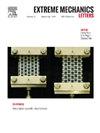Twist deformation of physical trefoil knots
IF 4.3
3区 工程技术
Q2 MATERIALS SCIENCE, MULTIDISCIPLINARY
引用次数: 0
Abstract
Knots across various length scales, from micro to macro-scales, such as polymers, DNA, shoelaces, and surgery, serving their unique mechanical properties. The shapes of ideal knots have been extensively studied in the context of knot theory, while those of physical knots have only been recently discussed in the literature. The complex interplay of elasticity and geometry, such as bending, twisting, and contact, needs to be disentangled to predict their deformation. Still, the unified understanding of the deformation of physical knots is insufficient. Here, we focus on the trefoil knot, a closed knot with a nontrivial topology, and study the relationship between the shapes of the trefoil knot and applied physical twists, combining experiments and simulations. As we twist the elastomeric rod, the knot becomes either tightened or loosened, preserving the original three-fold symmetry, and then buckles and exhibits symmetry breaking at critical angles. The curvature profiles computed through the X-ray tomography (CT) analysis also exhibit similar symmetry breaking. The transition would be triggered by the mechanical instability, where the imposed twist energy is converted into the bending energy. The phase transition observed here is analogous to the classical buckling phenomena of elastic rings known as the Michell instability. We find that the twist buckling instability of the trefoil knot results from the interplay of bending, twisting, and contact properties of the rod. In other words, the buckling of the knot is predictable based on the elasticity and geometry of rods, which would be useful in avoiding or even utilizing their buckling in practical engineering applications such as surgery and the shipping industry.

物理三叶结的捻度变形
从微观到宏观的各种长度尺度的结,如聚合物、DNA、鞋带和手术,都具有独特的机械性能。在结理论的背景下,理想结的形状已经得到了广泛的研究,而物理结的形状最近才在文献中得到讨论。弹性和几何的复杂相互作用,如弯曲、扭曲和接触,需要解开纠缠,以预测它们的变形。然而,对物理结变形的统一认识是不够的。本文以具有非平凡拓扑结构的三叶结为研究对象,结合实验和仿真,研究了三叶结形状与应用物理扭转之间的关系。当我们扭动弹性体杆时,结要么变紧,要么变松,保持原来的三重对称,然后在临界角度弯曲并呈现对称性破坏。通过x射线断层扫描(μCT)分析计算的曲率分布也表现出类似的对称性破缺。这种转变将由机械不稳定性触发,其中施加的扭转能转化为弯曲能。这里观察到的相变类似于称为米歇尔不稳定性的弹性环的经典屈曲现象。研究发现,三叶结的扭转屈曲失稳是由杆的弯曲、扭转和接触性能共同作用的结果。换句话说,基于杆的弹性和几何形状,结的屈曲是可预测的,这将有助于避免甚至利用其在实际工程应用中的屈曲,如外科手术和航运业。
本文章由计算机程序翻译,如有差异,请以英文原文为准。
求助全文
约1分钟内获得全文
求助全文
来源期刊

Extreme Mechanics Letters
Engineering-Mechanics of Materials
CiteScore
9.20
自引率
4.30%
发文量
179
审稿时长
45 days
期刊介绍:
Extreme Mechanics Letters (EML) enables rapid communication of research that highlights the role of mechanics in multi-disciplinary areas across materials science, physics, chemistry, biology, medicine and engineering. Emphasis is on the impact, depth and originality of new concepts, methods and observations at the forefront of applied sciences.
 求助内容:
求助内容: 应助结果提醒方式:
应助结果提醒方式:


